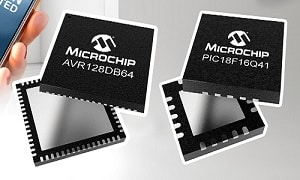These MCUs are ideal for analogue signal conditioning in space-constrained sensing and measuring applications
 Sensor-based Internet of Things (IoT) applications rely on a combination of analogue functionality and digital control capability to meet a challenging list of requirements such as low cost, small size, performance and low power.
Sensor-based Internet of Things (IoT) applications rely on a combination of analogue functionality and digital control capability to meet a challenging list of requirements such as low cost, small size, performance and low power.
Addressing this challenge are the PIC18-Q41 and AVR DB MCU families that claim to combine advanced analogue peripherals and multi-voltage operation with inter-peripheral connections for increased system integration and reduced signal acquisition times, and offer the convenience and efficiency of operating in a single design environment.
Suited For IoT and AI At-The-Edge
To address the need for signal conditioning in space-constrained sensing and measuring applications such as IoT end nodes and industrial, medical devices, wearables, automotive and lighting systems, the PIC18-Q41 MCU has a configurable Operational Amplifier (Op-Amp) and Analogue-to-Digital Converter (ADC) with computation and Digital-to-Analogue Converters (DACs). It is particularly well-suited for IoT and large-scale artificial intelligence (AI) at-the-edge, including predictive maintenance edge nodes in a smart factory. Offered in compact 14 and 20-pin packages, the PIC18-Q41 MCU also makes a good companion to Microchip’s 32-bit MCUs and other controllers that require analogue integration.
Analogue Signal Conditioning
Mixed-signal IoT systems often include multiple power domains. The AVR DB MCU simplifies the challenges of these designs while reducing cost by integrating true bi-directional level shifters. This feature lowers cost in a wide range of applications including automotive, appliances, HVAC and liquid measurement. The addition of three independent and highly configurable op-amps, a 12-bit differential ADC, 10-bit DAC, three zero-cross detectors and Core Independent Peripherals (CIPs) makes the AVR DB MCU ideal for any application involving analogue signal conditioning and processing functions.
Additional Support
The PIC18-Q41 and AVR DB MCU product families are supported by MPLAB X Integrated Development Environment (IDE) of Microchip Technology. Its MPLAB Code Configurator (MCC) and the MPLAB Mindi Analog Simulator provide a graphical interface to configure peripherals and functions specific to an application.
In addition to MCC, the AVR DB is supported by Atmel START, Atmel Studio and third-party tools such as IAR and the GCC C compiler. MCC and START help analogue and digital designers to easily configure an op-amp system for various typical use cases through a graphical user interface with no coding required.
“With a unified, seamless development tool experience, designers can use these MCUs as a single-chip controller, or as an intelligent analogue signal conditioning component in a larger system,” said Greg Robinson, associate vice president of marketing for Microchip’s 8-bit microcontroller business unit.
Both MCU families offer compact, cost-effective development boards as well: the PIC18F16Q41 Curiosity Nano Evaluation Kit (EV26Q64A) and the AVR DB Curiosity Nano Evaluation Kit (EV35L43A), built with programming and debugging capabilities.
The PIC18-Q41 and AVR DB MCUs are offered in a range of memory sizes, packages and price points and can be obtained from Microchip Technology or its
authorised distributor.






